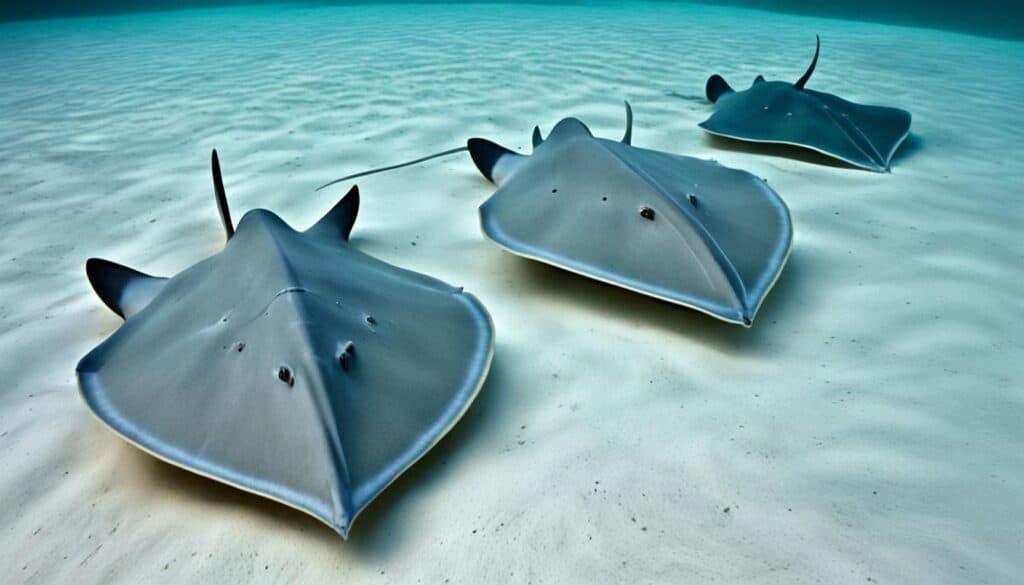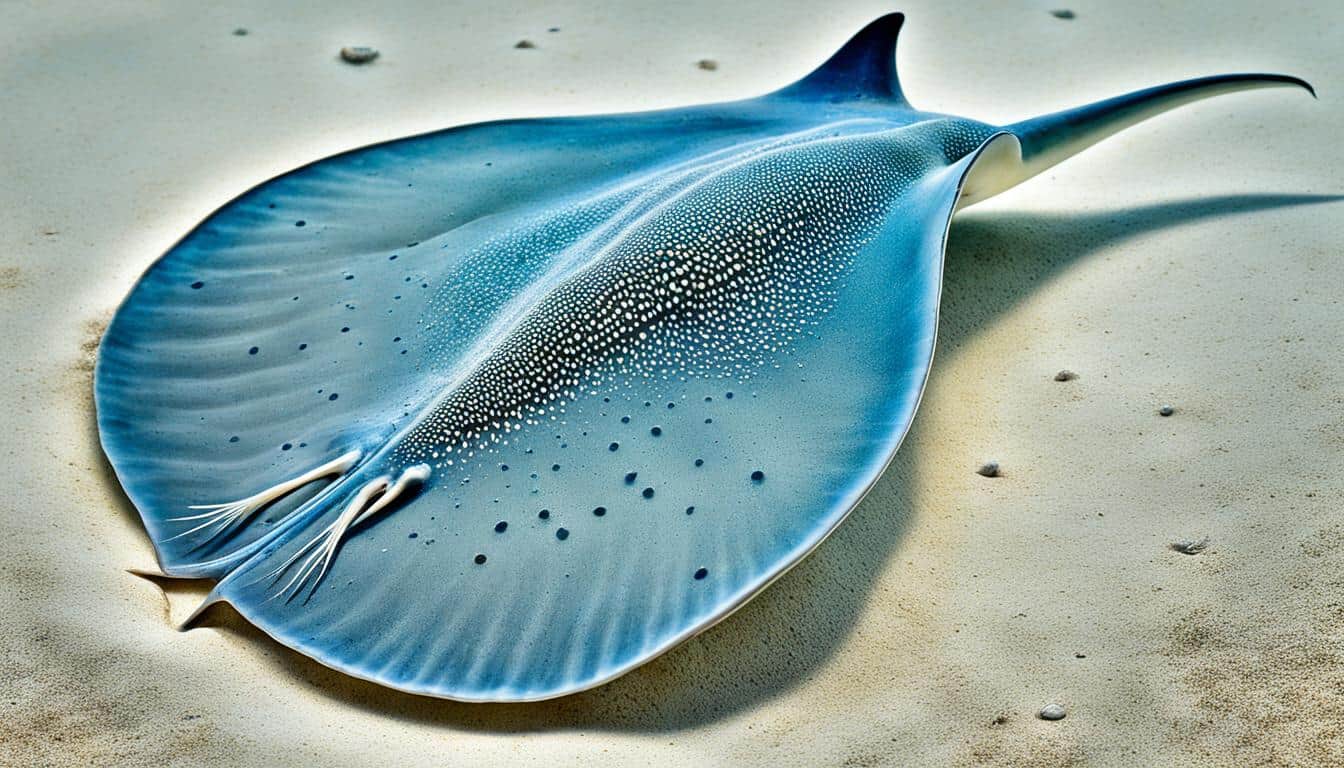Stingrays are fascinating marine creatures that belong to the group Myliobatoidei. They are flat fish closely related to sharks. This makes them quite intriguing, especially when you learn about their unique features and how they live.
These fish live in warm coastal waters, often hiding in the sand on the ocean floor. They ambush their prey, showing how clever they are at hunting. So, when you ask what are stingrays?, you’ll discover they are skilled hunters.
Their anatomy is quite striking, with broad, rounded fins that help them move through the water smoothly. Their tail has venomous spines, which they use to protect themselves from predators. Learning more about stingrays helps us understand their importance in the ocean.
Overview of Stingrays
Stingrays are a group of marine animals known for their unique features. They have special adaptations and classifications. They belong to two main families: Dasyatidae and Urolophidae. This helps us identify different types of stingrays and their unique traits.
Definition and Classification
Stingrays are fish with flat bodies and long tails. They have broad fins that help them swim. These fins let them move through the water by flapping or undulating their bodies. This anatomy is key to their survival.
Physical Characteristics
Stingrays have flat bodies that help them blend into the sand or mud. This makes them hard to spot for predators and helps them catch prey. They also have venomous spines on their tails for defense. These features show their beauty and how they’ve evolved.
| Characteristic | Details |
|---|---|
| Body Shape | Flattened, with broad fins |
| Tail | Long and flexible, often with venomous spines |
| Movement | Gliding through water using fins or undulating motions |
| Camouflage | Effective in sandy or muddy seabeds |
What are stingrays?
Stingrays live in oceans all over the world. They are interesting creatures that many people love to learn about. By exploring stingray facts, you can get a better understanding of their lives under the sea. These creatures have unique anatomy and behaviors that scientists and regular people find fascinating.
General Facts
Stingrays eat mostly meat, like clams, shrimp, crabs, and small fish. They can live for 15 to 25 years and grow up to 6.5 feet long. Many stingrays have venom in their spines. This venom can hurt humans if they step on them by accident. Knowing these facts is important for safety and caring for the ocean.
Unique Features
Stingrays have a special feature called the ampullae of Lorenzini. These help them feel electrical signals from other animals. This helps them hunt better, even in murky water. They have their mouths on the bottom for catching food and eyes on top for seeing while sneaking up.
| Characteristic | Description |
|---|---|
| Diet | Carnivorous, consuming clams, shrimp, crabs, and small fish |
| Life Span | 15 to 25 years |
| Size | Up to 6.5 feet in length |
| Venom | Present in many species for defense |
| Sensory Adaptation | Ampullae of Lorenzini for detecting electrical signals |
Stingrays Information
Learning about stingrays covers their biology, like their life span and anatomy. Each type has its own traits that help them in their environment.
Life Span and Size
Stingrays can live from 15 to 25 years in the wild, depending on the type. The Australian stingray can grow up to 7 feet long. As they get older, stingrays get much bigger than younger ones, showing how they grow differently.
Skeleton Structure
Stingrays have a unique skeleton. They don’t have bones like other fish; their skeletons are all cartilage. This material is also found in human ears and noses and makes them flexible.
This flexibility helps them move smoothly underwater. It also makes their swimming style and how they adapt to different places unique.
Stingrays Types
Learning about the different stingray types can really deepen your respect for these amazing creatures. There are many families and species, each with their own special traits and ways of living.
Different Families and Species
Stingrays are part of families like Dasyatidae and Urolophidae. The Dasyatidae family includes the blue-spotted stingray, known for its bright spots. The Urolophidae family has round rays that are smaller and more compact. These stingrays show how they can adapt and survive in many water environments.
Commonly Known Types
Some well-known stingrays are the cow-nosed ray, manta ray, and electric ray. The manta ray is huge and moves in big groups, making it a sight to see. Electric rays can make electric currents to catch their food. Each type of stingray is important in the ocean, helping to make it a rich place for life.

| Stingray Type | Family | Unique Feature |
|---|---|---|
| Blue-Spotted Stingray | Dasyatidae | Vibrant blue spots |
| Cow-Nosed Ray | Dasyatidae | Distinctive cow-like snout |
| Manta Ray | Mobulidae | Large wingspan and migratory nature |
| Electric Ray | Ability to generate electric currents |
Stingrays Habitat
Learning about the stingrays habitat helps us appreciate these amazing creatures. They live in many places that give them safety and lots of food. Stingrays love warm, shallow waters where they can hide by digging into the sand or mud.
Preferred Environments
Stingrays prefer places that suit their way of life. These stingrays environments include:
- Coastal waters with sandy or muddy bottoms
- Seagrass beds that offer both food and shelter
- Estuaries where fresh and saltwater mix
- Coral reefs that have a variety of food
This lets stingrays hide from predators and catch their prey by surprise.
Geographic Distribution
The geographic distribution of stingrays covers oceans all over the world. You can find them mostly in:
- Tropical and subtropical areas, especially near the coast
- Shallow waters of the Caribbean Sea
- Parts of the Pacific and Indian Oceans
- Some freshwater rivers in certain places, like the Amazon
Their spread matches where they can find the best places to breed and hunt. Knowing they like warm, shallow waters helps us understand their movements and role in nature.
Stingrays Diet
Stingrays have an interesting diet that shows how they hunt and survive. They are meat-eaters that use special senses to find food. These senses help them find prey hidden under sand or mud.
Feeding Habits
Stingrays have a clever way of hunting. They surprise their prey because they blend in with the ocean floor. Their jaws are made to break open hard shells of their prey. This way, they get a lot of nutrients from different types of food.
This hunting skill also helps keep their environment balanced. It shows how important stingrays are in their ecosystems.
Common Prey
Stingrays eat mollusks, small fish, and crustaceans like clams, shrimp, and crabs. These animals are common in their home, helping stingrays to survive. Their hunting skills and special senses make them top predators on the ocean floor.
FAQ
What are stingrays?
Stingrays are flat marine animals that belong to the group Myliobatoidei. They are related to sharks and are known for their unique look and behavior.
What is the habitat of stingrays?
Stingrays live in warm, shallow waters near the coast. They like sandy or muddy ocean bottoms and can also be found in some freshwater rivers.
What do stingrays eat?
Stingrays eat meat and feed on the bottom of the ocean. They eat invertebrates like clams, shrimp, and crabs, and small fish.
How do stingrays swim?
Stingrays swim by moving their wide fins or wiggling their bodies. This lets them move through the water gracefully.
What are some unique features of stingrays?
Stingrays have venom in their spines for defense. They also have special organs called ampullae of Lorenzini to detect electrical signals from their prey.
How long do stingrays live?
Stingrays live between 15 to 25 years in the wild.
What types of stingrays are there?
There are two main families of stingrays: Dasyatidae (whip-tailed rays) and Urolophidae (round rays). Some well-known species include the blue-spotted stingray and cow-nosed ray.
What is the skeleton structure of stingrays?
Stingrays have skeletons made of cartilage, like in human ears and noses. This makes them flexible for swimming.
How do stingrays catch their prey?
They use their electric sensors to hunt. Stingrays catch prey by surprise because they blend in well with sandy or muddy bottoms.
Where are stingrays commonly found?
Stingrays live in oceans all over the world. They do well in tropical and subtropical areas where their food is plentiful.







